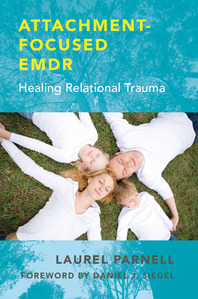
Attachment-Focused EMDR
Healing Relational Trauma
18 October 2013
Territory Rights — Worldwide.
Description
Integrating the latest in attachment theory and research into the use of EMDR.
Much has been written about trauma and neglect and the damage they do to the developing brain. But little has been written or researched about the potential to heal these attachment wounds and address the damage sustained from neglect or poor parenting in early childhood. This book presents a therapy that focuses on precisely these areas. Laurel Parnell, leader and innovator in the field of eye-movement desensitization and reprocessing (EMDR), offers us a way to embrace two often separate worlds of knowing: the science of early attachment relationships and the practice of healing within an EMDR framework. This beautifully written and clinically practical book combines attachment theory, one of the most dynamic theoretical areas in psychotherapy today, with EMDR to teach therapists a new way of healing clients with relational trauma and attachment deficits.
Readers will find science-based ideas about how our early relationships shape the way the mind and brain develop from our young years into our adult lives. Our connections with caregivers induce neural circuit firings that persist throughout our lives, shaping how we think, feel, remember, and behave. When we are lucky enough to have secure attachment experiences in which we feel seen, safe, soothed, and secure—the “four S’s of attachment” that serve as the foundation for a healthy mind—these relational experiences stimulate the neuronal activation and growth of the integrative fibers of the brain.
EMDR is a powerful tool for catalyzing integration in an individual across several domains, including memory, narrative, state, and vertical and bilateral integration. In Laurel Parnell’s attachment-based modifications of the EMDR approach, the structural foundations of this integrative framework are adapted to further catalyze integration for individuals who have experienced non-secure attachment and developmental trauma.
The book is divided into four parts. Part I lays the groundwork and outlines the five basic principles that guide and define the work. Part II provides information about attachment-repair resources available to clinicians. This section can be used by therapists who are not trained in EMDR. Part III teaches therapists how to use EMDR specifically with an attachment-repair orientation, including client preparation, target development, modifications of the standard EMDR protocol, desensitization, and using interweaves. Case material is used throughout. Part IV includes the presentation of three cases from different EMDR therapists who used attachment-focused EMDR with their clients. These cases illustrate what was discussed in the previous chapters and allow the reader to observe the theoretical concepts put into clinical practice—giving the history and background of the clients, actual EMDR sessions, attachment-repair interventions within these sessions and the rationale for them, and information about the effects of the interventions and the course of treatment.
Reviews
"Parnell’s book is well organized, easy to read, and gives clear examples of what the therapeutic process looks like when using AF-EMDR. . . . This highly accessible book is a welcome addition to the EMDR library and will enrich and inform the skills of mental health professionals who work with relational traumas." — Milton H. Erickson Foundation Newsletter
"[T]his book is exceptionally well written . . . . Parnell has taken the original model and made it significantly more accessible within the framework of attachment repair and healing trauma. . . . I will be reading her book again and sharing it with my colleagues." — PsychCentral
"This book has a clear writing style, a balanced blend of neuroscience and clinical artistry, and an unwavering focus on various types of resources to help even severely traumatized clients repair internal wounds and develop new skills for healthy interpersonal relationships. Clinical examples from Parnell’s own work, as well as extended cases provided by professionals she has trained and supervised, make the sound principles she espouses come alive. Ranging from a clear blueprint to prepare clients for intensive developmental reworking to advanced topics such as resource interweave sequencing, identifying and working with ego states that block processing, and the use of animals to repair disruption in early maternal attachment, Attachment-Focused EMDR contains something for every reader at every level of experience. Anyone who treats trauma will benefit from this well-crafted work. I cannot recommend this book highly enough!" — Maggie Phillips, author of Healing the Divided Self
"Realizing the critical importance of both client-therapist attunement and body sensory input, Laurel Parnell blends both to create a unique therapeutic container. Supported by many informative case study dialogues, this book provides a valuable template for the ideal therapeutic interactive process. This groundbreaking book is certain to set a new standard for trauma therapy." — Robert Scaer, MD, author of The Trauma Spectrum and 8 Keys to Brain-Body Balance
"Master clinician Laurel Parnell has written a book that does justice to the depth and effectiveness of her clinical work. Attachment-Focused EMDR reveals how healing deepens when the power of the EMDR method is brought to bear both upon clients’ relational traumas and upon the healing residing in the genuine connection between client and therapist. Readers will benefit from Parnell’s wisdom, clinical experience, and direct and down-to-earth writing style, as well as the case examples she provides with transcripts from actual sessions. I highly recommend this book—with its relational focus, it will enrich and deepen the practice of any clinician interested in working more effectively." — Diana Fosha, PhD, Developer of AEDP, co-editor of The Healing Power of Emotion








